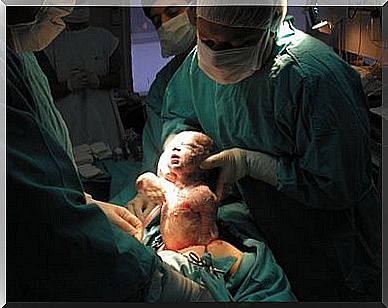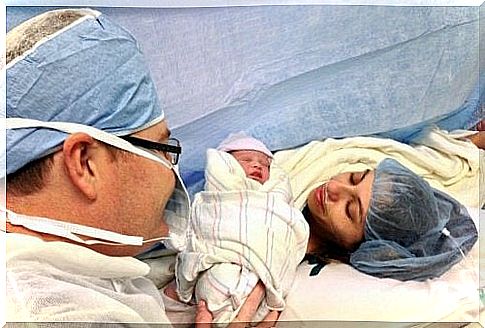3 Things To Know About Caesarean Section

What is a cesarean section? When is this procedure recommended? What does a typical recovery look like? Discover three things you need to know about a cesarean section in this article.
Towards the end of your pregnancy, all of your friends and family may be asking you, “Natural delivery or cesarean section?” You should answer this question with what you and your gynecologist have decided. But keep in mind that this may not be the final decision.
You may have several doubts after being asked this question. There will be an inevitable discussion about the pros and cons of both natural birth and cesarean section. This debate may lead you to question your own decision.
In this article from You are mama , we tell you three important facts about a caesarean section.
What you need to know about a cesarean section: what is it?
A cesarean section is a surgical procedure. An opening is made in the mother’s abdominal wall. This cut reaches the uterus, after which the baby is taken out.
This procedure is performed when the woman is conscious. It can be planned in advance or can be performed in an emergency if unforeseen complications arise.
This intervention lasts a maximum of one hour. Doctors proceed to anesthetize the mother.
This can be done with a single dose of immediately effective spinal anesthesia or an epidural delivered gradually through a tube inserted into the back.
Once the mother is numbed from the chest to the feet, the surgeon makes an incision in the abdomen just above the pubic area.
This allows the surgeon to open the uterus and amniotic sac to eventually remove the baby. Then the baby’s nose and mouth are cleaned and the umbilical cord is cut.
The neonatal team will check that the baby’s breathing is normal and that other vital signs are stable. Meanwhile, the midwife will remove the placenta and then close the incisions.
The mother can see her baby directly in the delivery room and even hold it in her arms.

What you need to know about a cesarean section: when is it performed?
There are several reasons why a pregnant woman may have a cesarean section instead of a vaginal delivery.
The gynecologist or obstetrician determines the method of delivery. This does not only take into account the health and position of the baby. But also with the woman’s previous deliveries and her medical history.
Doctors can make the decision to have a cesarean section in an emergency or they can schedule it in advance.
When should you schedule a cesarean section?
A Caesarean section should be scheduled if:
- you have previously had a “classic” caesarean section with a vertical uterine incision (not often). Even if you have had more than one caesarean section. These are both factors that can increase the risk of a uterine rupture during vaginal delivery.
- you have had another uterine surgery, such as a myomectomy (removal of fibroids).
- the child is sitting in the womb with the buttocks down or lying on his side.
- the baby has an illness or a birth defect that puts you at risk for a vaginal delivery.
- you are expecting more than one baby. Some twins can be born with a vaginal delivery. If triplets or more babies are on the way, a cesarean section is necessary.
- When you are expecting a very large baby, especially if you have diabetes.
- you have had another baby of the same or smaller size who suffered severe trauma during a vaginal delivery.
- the placenta is at the bottom of the uterus and covers the cervix.
- an obstruction, such as a fibroid, complicates vaginal delivery.
emergency cesarean section
An emergency cesarean section is necessary if:
- the placenta detaches prematurely from the uterine wall.
- the uterus does not continue to dilate normally.
- the baby does not descend through the birth canal and dilation does not resume.
- the baby’s basal heart rate is not encouraging to the doctor.
- there is a prolapse of the umbilical cord that slips along the cervix and can cut off the baby’s oxygen supply.
What you need to know about a caesarean section: recovery and care
After a cesarean section, the mother’s recovery takes a lot of time and care. Hospitalization lasts an average of 4 days. It is imperative to take good care of the scar to prevent infections.
Resting at home for four weeks is also necessary. That’s why it’s a good idea to have someone take care of you and your baby.
Initially, you will feel pain when you sneeze, cough, or do anything that puts pressure on the abdomen.
Stay calm and use your hands or a pillow to hold the incision if this happens to you. This discomfort will pass quickly and your baby will be worth all the pain.
Two days after the cesarean section, you may also feel discomfort from the build-up of gas.
This is because the intestines need some time to adjust after surgery and childbirth. Walking a few laps in the hallway can get your digestive system going again.
The doctors will likely prescribe something to relieve the pain and help the body heal. They will also probably advise you to stay well hydrated to avoid constipation.
Over time you will see that this small incision will become almost imperceptible. Any discomfort is just a reminder of the struggle that brought you the greatest joy.









